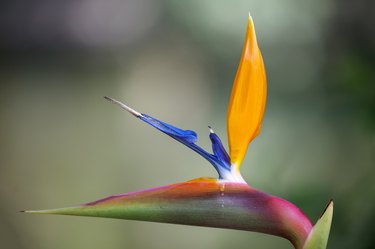
Bird of paradise species (Strelitzia reginae) is a frost-tender plant, but it can sometimes survive a freeze. Growing 3 1/2 to 4 feet tall and 3 to 4 feet wide, bird of paradise is hardy in U.S. Department of Agriculture plant hardiness zones 10 through 12, advises Missouri Botanical Garden. In other USDA zones, it must be grown indoors or moved indoors in the fall before the first average local frost date.
Covering and mulching bird of paradise offers some frost protection. If a plant is accidentally exposed to freezing temperatures, new stems sometimes appear in spring.
Video of the Day
Video of the Day
Bird of Paradise Frost Protection
When frosts are forecast, a bird of paradise plant must be protected with mulch and a cover. Short periods at 24 degrees Fahrenheit damage the plant but usually, it can recover, advises the University of Florida IFAS Extension. Bird of paradise plant cold tolerance below 24 F is minimal and exposure to lower temperatures, especially for more than a few hours, can severely damage plant stems and roots and the plant may not recover.
Spread a layer of straw, dry leaves, fine shredded bark or another fine, light mulch 4 to 5 inches deep around the bird of paradise plant in fall, but don't allow the mulch to contact the plant's stems. In the late afternoon or early evening before a frosty night, cover the bird of paradise with cotton sheets or seven or eight layers of newspaper. Remove the covering in the morning when temperatures rise again. The mulch can stay in place all winter.
Tip
Frost sometimes penetrates where a covering touches plant stems or leaves. Place a large cardboard box over a bird of paradise plant or make a cage of chicken wire to spread coverings over for additional protection.
Treat Frost Damage
Discolored, limp wet leaves and stems are some signs of frost damage on a bird of paradise plant. Pruning away the damaged areas prevents the decay from spreading. If the bird of paradise roots haven't been damaged, the plant may return when temperatures rise in spring.
Wipe pruning shear blades with a cloth that was soaked in rubbing alcohol, and prune the damaged stems and leaves 2 to 3 inches into healthy tissue. When the whole plant has suffered frost damage, prune the stems at ground level. Wipe the pruning shear blades with rubbing alcohol again when you've finished. Spread mulch over the root area in case of further frosts.
Long-Term Effects
Frost reduces blooms or prevents a bird of paradise plant from flowering and affects the plant's growth. Flowers and developing flower buds are the first plant parts frost affects. The damage may not be obvious until later in the year when no blooms appear. Provided the plant receives frost protection the following winter, flowering should resume as normal.
A plant that's regularly exposed to temperatures outside its hardiness zones doesn't grow well. In USDA zones 9 and colder, bring bird of paradise indoors in fall and place the plant in a sunny, frost-free area of the home.
Tip
Bird of paradise temperatures between 55 and 65 F at night provide optimal growing conditions for a bird of paradise plant.